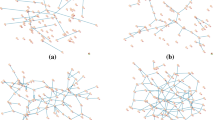Abstract
This paper describes a simple diffusion process whereby to discover the dynamics of emergent smart business network structures and their performance in view of business collaboration patterns over time. They include the destabilizing effects of business relationship tie-up’s or break-downs, and are discussed various partner evaluation, filtering and self-preference strategies. Three real life cases of business network dynamics are discussed based on data from the high tech sector. Lessons learnt from such cases are reported regarding overall smart network dynamic parameters with respect to local interaction strategies.
Similar content being viewed by others
References
Allen F, Gale D (2000) Financial contagion. J Polit Econ 108:1–33
Bonacich P (1987) Power and centrality: a family of measures. Am J Sociol 92:1170–1182
Braha D, Bra-Yam Y (2005) Information flow structure in large scale product development organizational networks. In: Vervest P, Van Heck E, Preiss K, Pau L-F (eds) Smart business networks. Springer, Berlin, pp 105–205
Busquets J (2010) Orchestrating smart business network dynamics for innovation. Eur J Inf Syst 19:481–493
Carley K (2003) Dynamic network analysis. Dynamic social network modelling and analysis. In: Workshop summary and papers, The National Academies Press, Washington
Ebel H, Davidsen J, Bornholt S (2002) Dynamics of social networks. Complex Adapt Syst, Part I 8:24–27
Erdös P, Renyi A (1959) On random graphs. Publicationes Mathematicae 6:290–297
Gnecco G, Sanguinetti M (2009) The weight-decay technique in learning from data: an optimisation point of view. Comput Manag Sci J 6(1):53–79
Gottschalk P (2007) Business dynamics in information technology. IGI Publishing, Hershey
Kuperman M, Abramson G (2001) Small world effect in an epidemiological model. Phys Rev Lett 86: 2909–2912
Maringer D, Ramtohul T (2012) Regime-witching recurrent reinforcement learning for investment decision making. Comput Manag Sci J 9(1):89–107
Milgram S (1967) The small world problem. Psychol Today 2:60–67
Nier J, Yang T, Yorulmazer A (2007) Network models and financial stability. J Econ Dyn Control 31: 2033–2060
Pau L-F (2005) Smart business networks: architectural aspects and risks. In: Clemm A, Feston O (eds) Proceedings 9th international IEEE/IFIP conference on information management (IM). IEEE Publications, Piscataway, pp 151–155
Todeva E (2000) Analysis of business network dynamics. In: Proceedings 6th annual organization science winter conference, Keystone, Colorado. Available at SSRN. http://ssrn.com/abstract=1458965
Van der Aalst W, Stahl C (2011) Modeling business processes: a Petri net-oriented approach. The MIT Press, Cambridge
Vervest P, Heck E, Preiss K, Pau L-F (2004) Introduction to smart business networks. J Inf Technol 19: 225–227
Wiesemann W (2012) Optimization of temporal networks under uncertainty. Springer, London
Author information
Authors and Affiliations
Corresponding author
Electronic supplementary material
Below is the link to the electronic supplementary material.
Appendix: numerical case
Appendix: numerical case
This simple three-party numerical case illustrates the notions introduced in this paper, and the corresponding results. Because dynamics are involved, even with this small number of partners and 8 business interactions, the results are too bulky to be published “in extenso”.
\(Assumptions\!\!:\) A three-party 2-resource category example is taken, with non-time dependent resource allocations; five successive stages are considered:
r(1,2,,1) = 2,000; r(1,3,.,1) = 700; r(2,1,.,1) = 8,000; r(2,3,.,1) = 2,500; r(3,1,.,1) = 2,500; r(3,2,.,1) = 3,000
r(1,2,.,2 = 1,000; r(1,3,.,2) = 6,000; r(2,1,.,2) = 900; r(2,3,.,2) = 2,000; r(3,1,.,2) = 4,500; r(3,2,.,2) = 700
The initial (t = 0) self-fulfillment grades are:
Fulfill(1,2,0) = 0,2; Fulfill(1,3,0) = 0,2; Fulfill(2,1,0) = 0,1; Fulfill(2,3,0) = 0,1; Fulfill(3,1,0) = 0,7; Fulfill(3,2,0) = 0,9
The initial partnership degrees are set equal to d(i, j, 0) = 5,000. The fulfillment costs \(C{\textit{(}}j,i,t{\textit{)}}\) are set proportional, with a coefficient of 0,4, to net revenues accrued by task allocation. The set-up costs Setup-costs (d(i, j, t)) are set to be proportional to \(d\textit{(}i,j,t\textit{)}\) with a fixed coefficient of 0,08.
\({Results}\)
For diffusion process constants \(k1=0,8\) and \(k2= 0,3,\) the following dynamic outcomes are observed:
-
a.
The interaction profits \(p\textit{(}j,i,t\textit{)}\) have very fast dynamics; the profits of business between (1, 2), (1, 3) remain positive, as well as up to and including t = 2 between (2, 3). The interaction profits between (2,1) run at a loss until halted after t = 2.This means that between partners 1 and 2, there is on-going business, but it onlylasts one way.
-
b.
Regarding cumulated profits \(P{\textit{(}}i,t{\textit{)}}\)(see Table 3), only partner “1” runs constant profits, while partner “2” has swings until getting out at t = 3 from any interaction, and partner “3” starts with a loss, and gets out from t = 1.
-
c.
The partner selection rule exhibits swings as one would expect (see Table 4); for periods from t = 1 until t = 3, partner “1” outsources preferentially to partner “2”, to stop it at t = 4.
-
d.
The degree of cooperation \(d{\textit{(}}j,i,t{\textit{)}}\) grows fastest between (1, 3), while the interactions between (1, 2) and (2, 1) have comparable evolutions.The interactions (3, 1) and (3, 2) fall fast, showing that partner “3” is progressively outsmarted by “1” and “2”.
Rights and permissions
About this article
Cite this article
Pau, LF. Discovering the dynamics of smart business networks. Comput Manag Sci 11, 445–458 (2014). https://doi.org/10.1007/s10287-013-0162-x
Received:
Accepted:
Published:
Issue Date:
DOI: https://doi.org/10.1007/s10287-013-0162-x




